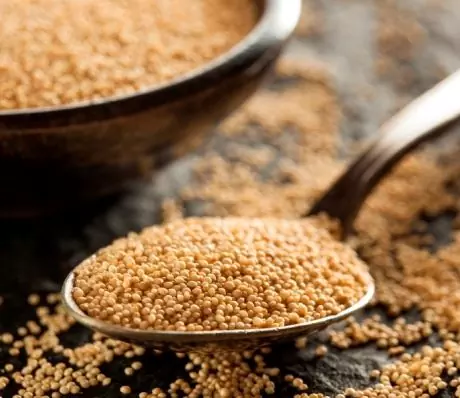- Author Rachel Wainwright [email protected].
- Public 2023-12-15 07:39.
- Last modified 2025-11-02 20:14.
Carambola
Carambola is a tropical tree from the Acid family, which has acataceous leaves, a dense crown and reaches a height of 4-5 meters.
The ratio of BJU in the product

Source: depositphotos.com How to burn 31 kcal?
| Walking | 8 minutes |
| Jogging | 3 min. |
| Swimming | 3 min. |
| A bike | 4 minutes |
| Aerobics | 6 minutes |
| Household chores | 10 min. |
Biological features and distribution
Carambola is a moisture-loving tree that grows mainly in the tropical climates of South America and East Asia. The tree is most widespread in Brazil, Sri Lanka, India, USA, Ghana, Indonesia and Israel.
Carambola fruits are star-shaped and yellowish. The pulp of the fruit is juicy, crispy and may have small ribbed growths, which contain a large amount of vitamin C.
Ripe carambola fruits are amber in color and differ in taste, depending on the varieties. The five-pointed fruits have a sweet and sour taste, and the six-pointed fruits with massive growths have a sweet taste.
Some carambola varieties taste like apples, grapes and plums, while others are similar to gooseberries and lemon.
Useful properties of carambola
The beneficial properties of carambola are high, thanks to the composition, which is rich in phosphorus, iron, organic acids, calcium and potassium. The composition of the fruits includes vitamins of group B and C, beta-carotene, provitamins, ascorbic acid.
In ancient Asia, the leaves and flowers of carambola were actively used in folk medicine to treat various diseases.
Currently, in India, this fruit is used as a hemostatic agent, as well as an ingredient in medications for hemorrhoids, fever, diarrhea and hangover.
The candied carambola fruits are anti-inflammatory, decongestant and choleretic.
In Brazil, a decoction of the fruits and leaves of this tree is used as an antiemetic and pain reliever. Crushed carambola leaves are used to treat lichen, smallpox and as an anthelmintic.
As a result of scientific research, the content of glutamic acid was found in the composition of the roots and leaves of the tree, which is an effective antidote for intoxication.
The seeds of carambola fruits are used as a sedative and antispasmodic agent for diseases of the digestive tract and bronchial asthma.
The beneficial properties of carambola are aimed at enhancing the protective functions of the human body, lowering blood pressure, normalizing blood sugar, and also effectively against headaches and dizziness.
Calorie content
Carambola is a low-calorie fruit with 31 kcal. Also, the fruits contain 7 g of carbohydrates and 1 g of protein.
Application of carambola
Carambola has a pleasant sour-sweet taste and quenches thirst well. In different countries of the world, this fruit is used to prepare many dishes.
In Europe, carambola is mainly used to decorate ice cream, cocktails and desserts. In Sri Lanka and India, the fruit is eaten raw along with the peel. In China, this fruit is added to fish dishes, and in Hawaii, sherbet is made from it with the addition of lemon.
Carambola makes a good sauce for meat dishes, to which horseradish, celery, vinegar and spices are added. Fruit gives meat, vegetable and fish dishes an unusual but pleasant aftertaste.
In South Asia and America, unripe carambola is used as a vegetable, pickled and salted, and is also used to make stews. And from the ripe fruit of the fruit, delicious mashed potatoes, puddings, juices, jellies and fruit salads are obtained.

Contraindications of carambola
Carambola is contraindicated for people with severe diseases of the digestive system, including gastritis, peptic ulcer and enterocolitis.
The fruit contains a large amount of oxalic acid and vitamin C, which can provoke kidney pathologies and salt metabolism disorders.
With caution, carambola should be used with individual intolerance to ascorbic acid and a predisposition to allergic reactions.
YouTube video related to the article:
Found a mistake in the text? Select it and press Ctrl + Enter.






